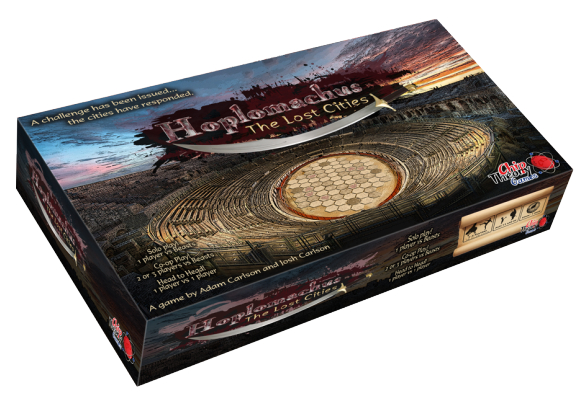
The Basics:
- For ages 8 and up (publisher suggests 12+)
- For 1 to 3 players (solo, competitive, and cooperative)
- Approximately 60 minutes to complete
Geek Skills:
- Active Listening & Communication
- Counting & Math
- Logical & Critical Decision Making
- Reading
- Pattern/Color Matching
- Strategy & Tactics
- Risk vs. Reward
- Visuospatial Skills
- Cooperative & Team Play
- Hand/Resource Management
- Area Control
Learning Curve:
- Child – Easy
- Adult – Easy
Theme & Narrative:
- Command a group of your empire’s best warriors and prove to the world your worth
Endorsements:
- Gamer Geek approved!
- Parent Geek approved!
- Child Geek approved!
See Also:
Overview
The great arena has thrilled and horrified for generations. Within its walls and on its sandy floor, countless brave men and horrific beasts have bled and perished. It is a symbol of strength, a proving ground for future legends, and a visible reminder to enemies the might and brutality of the Roman Empire. The great arena’s renown has reached all the corners of the world, both known and unknown, and many exotic wonders come to delight the crowds. But on this day, and greatly troubling to the powers that be, new contestants have joined the ranks of the combatants that hail from far greater and thought lost civilizations. While they mesmerize the crowds, the ruling body of the Roman Empire knows they are emissaries of a possible war to come.
Hoplomachus: The Lost Cities, by Chip Theory Games, is comprised of 1 game mat that represents the arena, 4 Reference cards, 10 six-sided dice, 3 Crowd Favor tracking beads, 3 Chip bags, 100 Health chips, 15 Unit and Tactic chips representing the empire of Atlantis, 15 Unit and Tactic chips representing the empire of Xanadu, 15 Unit and Tactic chips representing the empire of El Dorado, 6 Boss chips, 8 Beast/Criminal chips, 12 Crowd Favor Reward chips, 1 Flip coin (representing “Heads” or “Tails”), and 3 City chips. The components are of excellent quality. The chips are thick and weighty, with the stickers on them securely mounted. The game mat is a solid rubber matting with an excellent printing of the arena on its surface making it very easy to read. The game box itself has been designed to not only easily fit all the current game components, but also to easily incorporate the pieces from future game expansions.
Venatus Constructum (Game Set Up)
To set up the game, first roll out the game mat and place it in the center of the playing area. Place the Health chips and dice to one side and within easy reach of both players. At this time, also place the Crowd Favor tracking beads on the Crowd Favor Meter’s “zero” position located on the game mat.
Second, have each player now select one of the three empires they will lead into battle and glory, taking all the chips that represent the empire of their choice, and placing them in front of them along with one Chip bag.
Third, gather all the Crowd Favor chips (white) and separate the Tactics from the Gladiators creating two stacks. Shuffle these two stacks and place face-down. Now draw 3 Tactic chips and place, face-down without looking, on each player’s Crowd Favor Meter on the Level 1, Level 2, and Level 3 positions. On the Level 4 position, draw 1 Gladiator and place it face-down without looking.
Fourth, each player now looks through their chips and finds the Champion (indicated with a “C”). This chip is temporarily set aside and the remaining chips are placed in the player’s Chip bag.
Fifth, complete any additional set up noted on the game mat or specific to a scenario (available on the Reference cards).
Sixth, use the Flip coin to determine which player goes first.
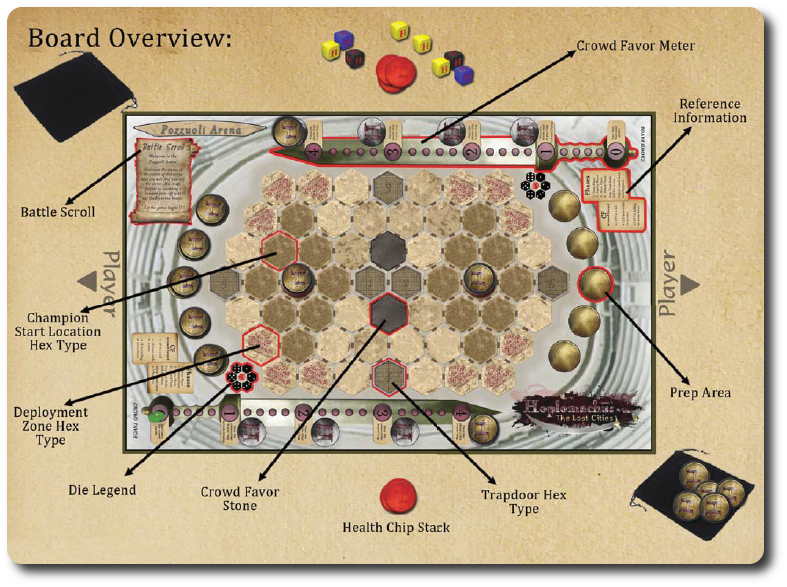
Bello Et Motu (Battle and Movement)
Before you play the game, you must know the basics of the art of combat. There is more to it than just staying out of harms way (although many would argue that’s the best policy). Tactics must be used and a strategy must be in place to achieve victory, as well as the ability to quickly adjust to the ever-changing conditions of the arena. This is made possible for the players by moving their gladiators and champions across the arena; winning crowd favor which provides additional abilities and renewed focus.
Gladiators
Each gladiator and champion chip represents that specific unit and contains a great deal of information about their abilities. This information is used throughout the duration of the game and until the chip in question meets as bloody end. A brief description of what each icon represents and its meaning are summarized here.
- Attack Range: the number of hexes the target unit must be within to be attacked – for example a range of 1 can only reach adjacent target units, but a range of 2 can strike any target unit 1 or 2 hexes away
- Health: the number of Health chips the unit starts with and is placed underneath it when it is placed on the game mat – when all the Health chips are removed, so is the unit
- Attack Power: the number of basic attack dice the unit uses in combat
- Move Range: the maximum number of hexes the unit can move on the player’s turn
- Tactical Range: the number of hexes the target unit must be within to receive and use the tactic – for example a range of 1 can only reach adjacent target units, but a range of 2 can target any target unit 1 or 2 hexes away – tactics can always be played on the unit that uses them (range of 0)
- Basic Attack Dice: indicates the dice colors used in combat for the unit’s basic attack
- Alternate Attack: indicates the name and dice used for the unit’s alternate attack (used instead of the unit’s basic attack)
- Ability: the unit’s special ability that can be used once per turn by the player and as soon as the unit is set on the game mat
- Unit Type: icon represents the type of unit the chip represents (gladiators, champions,beasts, and criminals, respectively)
- Unit Name: self-explanatory
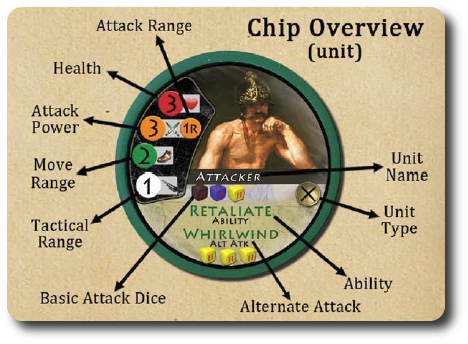
Movement
The arena is comprised of hexes and all units can move on these in any direction as long as there is no other unit blocking their path, although some units can move through other units. The move range on every unit indicates the maximum number of hexes the unit can take, but the player is never required to use them all. However, the player cannot “bank” the movement for use later in the round. Each unit can move once per turn.
Attacking
After movement (if any is taken) the unit can attack any other unit that is within range as indicated by the unit’s attack range. A player can either use the unit’s basic or alternate attack, but not both, and only get to attack with each unit once per turn. To determine if combat is successful, the player takes the number and color of dice indicated by the attack and any tactics available and rolls them, counting the number of the letter “H” that are shown. The “H” represents a hit and for every hit, the target unit will remove 1 Health chip. However, the player who owns the target unit might have a trick or two up their sleeve and be able to block some or all of the hits. If, however, the target unit’s Health chips are all removed, so is the target unit.
Crowd Favor
The arena is more than just tactics and strategy. It also about showmanship and spectacle. The more the crowd loves the player’s units, the more powerful they become, being bolstered by the crowd’s cheers and shouts of support. In game terms, Crowd Favor “unlocks” tactics on the Crowd Favor Meter that become available to the players. Crowd Favor is gained by removing a target unit from the arena during combat (awarding 2 Crowd Favor points), removing a beast or a criminal (awarding 2 Crowd Favor points), removing a boss (awarding 5 Crowd Favor points), or from occupying one or all of the Crowd Favor Stone locations in the arena with a units at the start of the round (awarding 1 Crowd Favor point for 1 occupied location or 3 Crowd Favor points for occupying both locations). All Crowd Favor points are immediately applied to the Crowd Favor Meter when they are gained.
But the crowd is fickle and wants a good show. While the player who unlocks a specific Crowd Favor Level is awarded, so to is the opponent. The player who unlocks a level on the Crowd Favor Meter is awarded an arena bonuses and the opponent is awarded the tactic chip!
Tactics
During the player’s deployment phase, they may play a tactic ship. Tactics can never be played on the champion or boss units and can only be played on a unit that is within tactical range of the unit that is using it, or the tactic can be played without any tactic range on a single unit the player owns.
Arena Units
Arena units, represented by beasts and criminals, are just like the player’s champions and gladiator units but they are only used during cooperative and solitaire games. Instead of moving as a normal unit, however, their movement is determined by rolling a six-sided die. The value rolled indicates from which Trap Door location they will first appear on the game board.
Beasts move the maximum number of hexes as they can and in the direction indicated by randomly rolling two six-sided die (one at a time), using the Die Legend on the game mat to determine the specific direction taken. They move their entire move range (for both die) until the unit either cannot move any further or comes into contact with a player’s unit. Once an arena unit is adjacent with another player’s unit, they are both considered “engaged” and neither unit can move until one of the two falls.
Criminals roll a six-sided die to determine if they move, move only 1 or move 2 hexes. Criminals always move towards a specific assigned Champion in play. Unlike beasts, player’s can engage and disengage from a criminal unit as often as they like.
Both beasts and criminals attack all adjacent units at once. If a boss beast or boss criminal is attacking, it has a special attack and requires some additional dice rolling.
Arena units take their turn after all the player’s have completed their turn.
Sanguinem Et Mortem (Blood and Death)
There are four different game modes to select from. These include a 2-player versus, 2-player cooperative, 3-player cooperative, and 1-player solitaire versions of the game. Game set up is now complete for 2-player versus, but the other three game modes will require additional game set up and are described below. Each of these game modes, their goals, and a brief description of game play is given in summary. We invite you to read the rule book for more details.
2-Player Versus
The goal of this game mode is to eliminate the opponent’s champion from the game mat. To begin, have each player take their champion and 10 Health chips. The players now stack the Health chips under their champion chip with the champion chip’s grayed out side facing up. This is chip is placed on any of champion start location hexes. The players now play the game taking a turn each and when both player’s have completed their turn, the round is over. On their turn, the players must complete the following phases in sequential order:
- Phase 1: Draw Chips
The player will draw a number of chips from their Chip bag to fill the player’s prep area in front of them. These are hidden from their opponent and placed face-down, but can be looked at by their owning player at any time. These are considered the player’s “hand” and can be used during the game. Chips are not an abundant resource, however, and the player must manage them to their best of their ability. If the player is ever unable to fill all the circles in their prep area, their champion unit will take 2 damage (removing 2 Health chips) at the start of every following turn! During this phase, the player also records any Crowd Favor points awarded for occupying the Crowd Favor Stones locations with their unites. - Phase 2: Deployment and Tactics
The player can now play chips currently in their prep area for a maximum of 2 chips per turn (unless this is the first round, in which case, the first player can only play 1 chip until the second round). Gladiator units are placed with Health chips underneath them in one of the deployment hexes. If none of the hexes are free, a unit cannot be deployed. Tactics cannot be played on champions or bosses. - Phase 3: Movement
Each unit may now move a maximum number of hexes as indicated by the unit’s move range. Units cannot move through another unit unless they have an ability that allows them to do so. Each unit moves once and can either use all or none of their total movement. However, once the unit is or is not moved, they cannot be moved again until the player’s next turn. Note that any units deployed during phase 2 cannot move during this phase until their next turn unless the unit has a specific ability that states otherwise. - Phase 4: Attack
Each unit may now attack a target unit that is within attack range. The player announces the target unit and the attack they will be using (basic or alternative). The dice are rolled and the target unit can attempt to block any hits. Combat is resolved for every unit one at a time and each unit can only attack once; however, target units can be attacked multiple times.
The game continues until one of the player’s looses their Champion.
1-Player Solitaire
The goal of this game mode is to eliminate the arena boss with at least 1 champion remaining.
Game set up differs from the 2-player versus mode. The game only lasts 3 rounds (or a single challenge round) and champions keep their existing health each round. All other units in play must reset and are redrawn at the start of each round of play. The player can only play 1 chip per turn.
For game set up, the player will select one empire and draw 6 gladiators and 1 tactic unit to use. Three Crowd Favor rewards and 1 Crowd Favor gladiator are also drawn and placed on the Crowd Favor Meter. The champion is placed as normal and 2 arena units (beasts or criminals) are drawn and placed on the trap door spaces on the game mat. Once any of these 2 arena units are dispatched, another is drawn to replaced it in the following round. Draw 1 boss and place it as well.
2-Player Cooperative
The goal of this game mode is to eliminate the arena bosses with both player’s champions remaining.
Game set up is the same as a 1-player solitaire game except players draw only 3 gladiator units and 1 tactic per round. Both of the players use one end of the arena and share the deployment hexes, playing one chip per turn. If a champion is eliminated from the arena, the owner of the champion can no longer deploy gladiator units or use tactics, but they still can play any active units in the arena. All Crowd Favor is shared as are any awarded Crowd Favor Rewards. The first player to reach each reward level takes the reward provided. All tactical range is also shared between the players. Two Boss units are used during this game mode.
3-Player Cooperative
The goal of this game mode is to eliminate the arena bosses with both player’s champions remaining.
Game set up is the same as a 2-player cooperative except players draw 2 gladiator units and 1 tactic per player. Additionally, 3 boss units are drawn and placed in the arena.
To learn more about Hoplomachus and read the full rules (of which we have only summarized here), see the game’s web site.
Prediction
This might sound like a big game, but the rules have made every turn very streamlined with four sequential steps that the players will take. This makes managing the many units possible. More over, this makes the game easy to teach. Visually, the game is pure eye candy with lots of great detail. The chips in the game are easy for big and small geek hands to hold, and the level of reading and math is simplified with the use of icons and letters. A player need only recognize what an icon means and count up to 10 to play the game.
I have no doubt, based on just reading the rules of the game, that Hoplomachus will appeal to the Gamer Geeks and Parent Geeks who are looking for a tactical and strategical game to play with friends and family. The Child Geeks will greatly enjoy looking at the game, but they might not be able to play it fully based on some of the more complex rules. We’ll simply have to see, but this game is already sparkling like a winner.
After explaining the game to my 5 and 8-year-old, giving several examples of how combat worked, use of abilities, and some of the more complex tactics they could use, they said they were ready to play. They are more eager than ever nowadays to get games on the table and would prefer to play the game and learn as they go versus listening to their father talk on and on about the game they want to play. And so, we set up the game mat for a 3-player cooperative game and got ready to bloody our swords. As I did so, I asked them their opinions on the game so far.
“Super, super cool!” ~ Liam (age 8)
“Can I train one of the beasts to be my pet in the battle, Daddy?” ~ Nyhus (age 5)
My oldest is totally geeked out about the game and is jumping up and down while my 5-year-old is much more subdued and looking over his chips again and again. Both, in their own way, are visibly pumped up and ready to get playing. Let’s see if it is a crowd pleaser or if it is a battle in futility.
Final Word
Wow. My little geeks greatly impressed me with how quickly they understood the game and took me to town. My 8-year-old was the strongest player (not surprising) but my 5-year-old also did exceptionally well, but not without a lot of help. He was confused more times than not about what some of his icons and the phase order. During each phase, however, he controlled his own game, making all the choices, and doing all the battles. But because he needed to be helped during each phase and told what needed to be done, we cannot recommend this game to little geeks his age. For my oldest little geek, the difficult was not the game rules but the opponent. He understood the game after only 2 rounds and was anticipating what actions needed to take place next and how best to move his units to take control of the arena. Due to his ability to understand the game, demonstrate meaningful tactical choices, and reacting to the changes in the game, we have no problem suggesting Hoplomachus is playable by little geeks as young as 8-years-old.
Parent Geeks didn’t care to play this game against each other, oddly enough, or even cooperatively. They just couldn’t buy into the idea of playing a wargame against their peers. Makes sense when you consider that this group, although skilled in games, is looking for a casual game play experience. Non-gamers didn’t have a problem learning the game, but like the Parent Geeks, didn’t warm up to the idea of playing a solitaire, competitive, or cooperative wargame. Where the Parent Geeks did a total reversal in their opinion of the game is when they played it with their family. Specifically, their kids. Hoplomachus proved to be a real joy for them and their little geeks as they fought toe-to-toe either together as a team or against each other as rivals. One Parent Geek proclaimed Hoplomachus to be is “new Chess“.
Gamer Geeks greatly enjoyed the game’s depth of strategy and tactics, the different abilities they could use with the units, and the need to manage their units like a general with area control thrown in for good measure. They also highly enjoyed the theme and the quality of detail the game had, making the entire experience from unboxing to game clean up, a pleasant and rewarding time.
My little geek’s first experience with the game back in 2012…
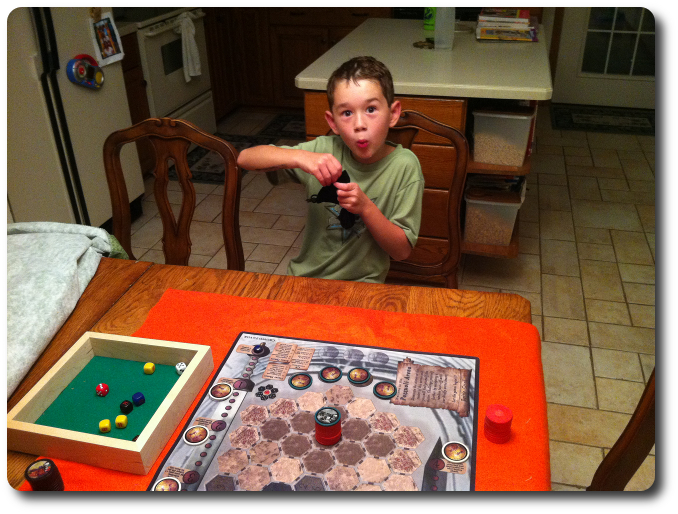
And him reading the rules and setting up the game by himself in 2013 using the final version of Hoplomachus…little geeks grow up way too fast…
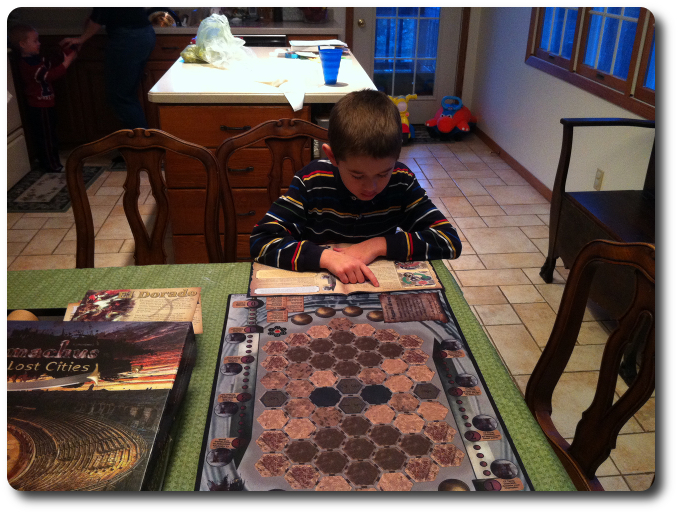
Gamer Geeks, this is an outstanding game that will require you to use all your skill to outwit and out think your opponent as you navigate the small arena with your units. Every move will count and will either put you in perfect position to crush your opponent or for your opponent to crush you. Tactics is made all the more important with the use of the tactic chips and the differently abilities of the units, complete with alternative attacks. There is always something for the players to think about. The game has depth but is not heavy and can be played very quickly. As the game progresses, it changes focus from full-out battle to a subtle game of area control and resource management. You must outlast your opponent and the only way to do that is to gain the crowd’s favor and control your forces both in and out of the arena. We don’t think it is risky to state you are going to love this game.
Parent Geeks, if you are looking for a straight forward wargame with a lot of depth to plunge and explore without the usually trappings of heavy game play and complex rules of engagement, this is the game for you. The Parent Geeks we played the game with loved it even more with their little geeks. This proved to be an excellent introductory wargame experience for those Parent Geeks looking to get their little geeks into more tactical games. The only negative we heard from the Parent Geeks is that there was too much combat. We took that comment and give it to you, the reader, to laugh at and ponder.
Child Geeks, this is a fun to play wargame that will require you to flex your brain muscles rather than your combat muscles. This is, in some ways, like a game of Chess, where movement and timing is exceedingly important. You will benefit greatly if you can think of your moves ahead of your turn and can react with a cool mind. The arena is always shifting and you will quickly learn that sometimes that best course of action is to run away instead of running towards battle.
I was greatly impressed with this game from the very start. I had the privilege of speaking to the game designers and hearing their personal story about how the game came about. Their passion for the game was palatable and left me feeling more excited about their vision of the game than the game itself. When I finally got the game to the table, my excitement shifted. It was now the game that excited me more and the promise of things to come mattered not, as I was too engrossed in the game play.
The game is still not yet perfect, however.
There are only three empires to use out of the box. That’s a lot for the first couple of games, but after playing this game 9 times in row (over a few days) when initially learning and teaching the game, I was desperate for something new. To be fair, I doubt there are many players who will play this game (or any game) that many times in a row. The good news is that the expansions will be adding more chips and arenas for the players to use. More chips means more options and more options means a wider variety in game play. Different arenas mean different rules and different thinking that will keep the game feeling fresh and exciting.
I stated earlier in the prepublished game review that I could not yet state if I “loved the game”. I can now say with total confidence that I am very much a fan. The game continues to thrill my little geeks (my 8 and 5-year-old have made up their own simpler rules so they can play together), it continues to challenge me, and the box has yet to collect dust. Considering the very large number of games I have, a box that does not collect dust is a rare thing. Perhaps I should make a “dust level” rating for my game reviews…mmmm…something to ponder.
I’ve said it once, and I’ll say it again! If you are looking for a strategic game of arena combat thematically set during the Roman Empire where players take on the roles of combatants hailing from ancient empires that requires a tactical mind with 4 different modes of play, draw your sword and engage Hoplomachus as soon as possible. It will smite you with its awesomeness.
But don’t take our word for it. Take a look at what some of our friends and fellow highly respected Gamer Geek reviewers have to say about the game!
- Crits Happen: A Critical Review of Hoplomachus: The Lost Cities
- InD20 Group Reviews Hoplomachus: The Lost Cities
This game was given to Father Geek as a review copy. Father Geek was not paid, bribed, wined, dined, or threatened in vain hopes of influencing this review. Such is the statuesque and legendary integrity of Father Geek.




Pingback: Hoplomachus Game Review (prepublished version) » Father Geek
Pingback: Arena Galdiators Game Review » Father Geek
Pingback: Arena Gladiators Game Review » Father Geek
Pingback: Hoplomachus Series Add-On Review - Father Geek